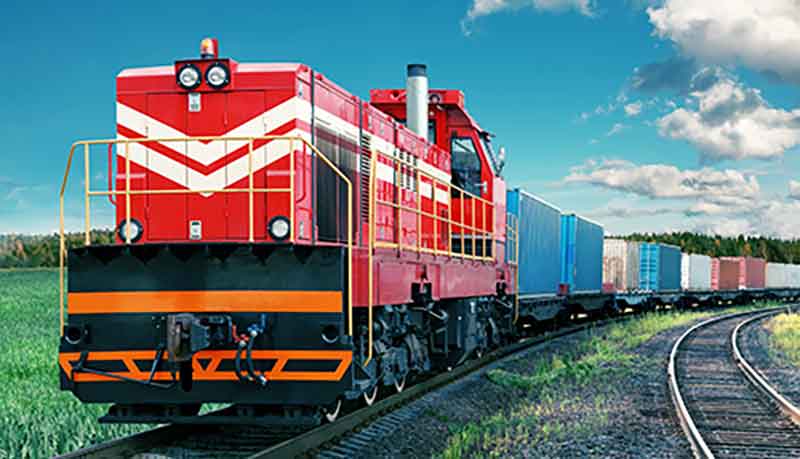When choosing the cargo shipping solution, a shipper aims to strike a balance between competitive prices with the best freight service. Intermodal transportation combines the efficiency and flexibility of various shipping methods to achieve this goal. This article will shed light on what intermodal is, how it works, and the benefit of intermodal transport.
What is intermodal transportation?
Intermodal transport uses a changeless intermodal container or road vehicle, shipping by multiple transportation methods without any cargo handling when transferring. Generally, the types of intermodal transportation involve railway, ocean, air, and truck, such as a combination of rail and vehicle transporting or ocean and drayage shipping, etc.
Intermodal freight transport can increase the security of the shipment as it transits large-sized goods in the same container until its arrival destination. With containerization and standardizing container sizes, the intermodal transport system became easier to handle. For this reason, intermodal shipping is also more lucrative and vital in global shipping and supply chain logistics.
Why is it important?
The more interconnected the world is, the more significant intermodal shipping will become. Nowadays, there are more than 25 million TEU containers shipping. According to Statista, the global intermodal freight transportation market is estimated to reach 36.2 billion U.S. dollars by 2026. These numbers will only ramp up as the cross-border trade routes and basic facilities spread worldwide.
Furthermore, many businesses depend on international shipping, such as online trade and e-commerce. So intermodal transport demand will increase as enterprise tap into new market territories. With its many advantages, intermodal freight transport is an often undervalued mode of shipping that can provide beneficial efficiencies for your supply chain.
How does intermodal transportation work?
Intermodal transport is a shipping strategy to deliver goods from the origin place to the terminal point over one shipping way. It commonly leverages drayage to shift the intermodal container to a warehouse, rail yard, or intermodal station and more. And the carrier will move the shipment by other transportation modes to the final place.
Below is the intermodal transportation example:
A manufacturer in China needs to ship the cargo to a retailer in the United States. For this, the manufacturer (seller) finds a freight forwarder to transport this shipment in a container by truck to a nearby port. And the cargo will be loaded onto a cargo ship, which would across the Pacific Ocean to a port on the West Coast of the United States.
Once the shipping containers arrive at the port in the US, the buyer requests their local carrier to load the goods onto a train and send them to the agreed inland rail terminal. After that, a drayage would drive them to the final warehouse for distribution.
In this example of intermodal transport, the seller and the buyer sign individual contracts with different logistics companies who will issue relevant bills of lading. The whole shipping process includes three methods of transportation: truck, train, and cargo ship. By using intermodal modes of transportation, it can take advantage of the strengths of each freight shipping, such as the speed of air freight and the cost-effectiveness of shipping by ocean or rail.

What are the benefits you can get?
The advantages of intermodal freight transportation boil down below points:
Cost-effective
You can enjoy more competitive prices as intermodal transport allows for several shipping ways in a single shipment. Because intermodal shipping requires a seamless transfer and less cargo process, it will come with lower handling costs. These prices can be predictable, so you can control and reduce the freight cost after comparing different combinations of transportation.
Environment friendly
Intermodal logistics is more environmentally than traditional transportation. According to research, a train can move a ton of cargo nearly 450 miles with a gallon of fuel, while a truck consumes more for the same goods and mileage. With intermodal transportation, it can reduce carbon emissions to a great extent.
Increased flexibility
Intermodal freight transport allows for greater flexibility in shipping planning and scheduling. It supports you in choosing the most appropriate intermodal mode for your shipments based on the type of cargo, distance, time constraints, and cost.
Safety and Security
The intermodal container will store your cargo throughout the whole shipping procedure. It also doesn’t need handling when shifting to another transportation. As no one can access the goods directly, it can decrease the risk of theft or damage during cargo freight. In addition, intermodal containers, just like a small warehouse, are designed securely and are easy to monitor. For these reasons, intermodal freight can ensure your cargo arrives safely.
Disadvantages of intermodal transportation
Intermodal transportation offers many advantages to enterprises transporting large goods across long distances. It is an efficient and environmental option helping improve the supply chain operations.
But on the other hand, your shipment structure will affect the intermodal freight cost. For instance, if your intermodal container is too heavy and needs special equipment like a crane to load it from a truck to a rail. It will lead to a higher infrastructure cost.
Furthermore, not all transportation routes (such as railroads) support shipping directly to all destinations, increasing the delivery time. As intermodal transport requires different carriers in charge of each mode of transit method, there’s a high chance of the shipping chain breaking at some point.
Coins always have two sides. Before considering intermodal freight transport, you should negotiate with each shipping company to avoid communication gaps and disarrangement for the loading or unloading and more. By the way, a professional freight forwarder can help you start intermodal shipping hassle-free.
What is the difference between intermodal and multimodal?
Intermodal and multimodal transport overall is recognized as the same shipping modes. Though both are the same in combining multiple ways to deliver the cargo, it still has differences. In intermodal transportation, it asks to take a separate contract for each shipping carrier, while multimodal transportation only one contract that covers the whole shipping. It means only one intermodal carrier takes responsibility and ensures the cargo freight deliver successfully, even if you use another freight carrier in multimodal.
When to choose intermodal logistics?
Intermodal logistics suit a variety of situations, but it is particularly beneficial when:
Lasting transportation distances
Intermodal shipping is fit for long-distance transportation, as long lines demand high fuel consumption. It allows goods to be transported more efficiently and cost-effectively over longer distances.
High freight volumes
Intermodal transport can also be effective when transporting large volumes of freight, as it allows for greater capacity and efficiency than using a single mode of transportation. But if you want to ship high-value goods, it’s recommended that you choose a direct and faster freight method like air shipping. Otherwise, intermodal is better for low and medium-value shipments.
Flexibility for delivery time
As it involves several shipping modes, intermodal transportation may require more time to complete than using a single freight transport. Therefore, you should schedule in advance and use intermodal when your freight time is flexible.
What role does ASL play in intermodal shipping?
To best implement an intermodal approach, it is imperative to survey the shipping mode and evaluate the different freight providers to find the best fit for your business. And a reliable freight forwarder can assist you with one-stop intermodal transport integration.
Airsupply Logistics, a bond bridge between shippers and carriers, has ten years of experience handling shipping. It will assess your shipment features and freight lane to determine the best intermodal service to meet your need. ASL also provides amazon intermodal, customized shipping solutions, etc. For more details, please feel free to contact and check with the ASL officials team.




